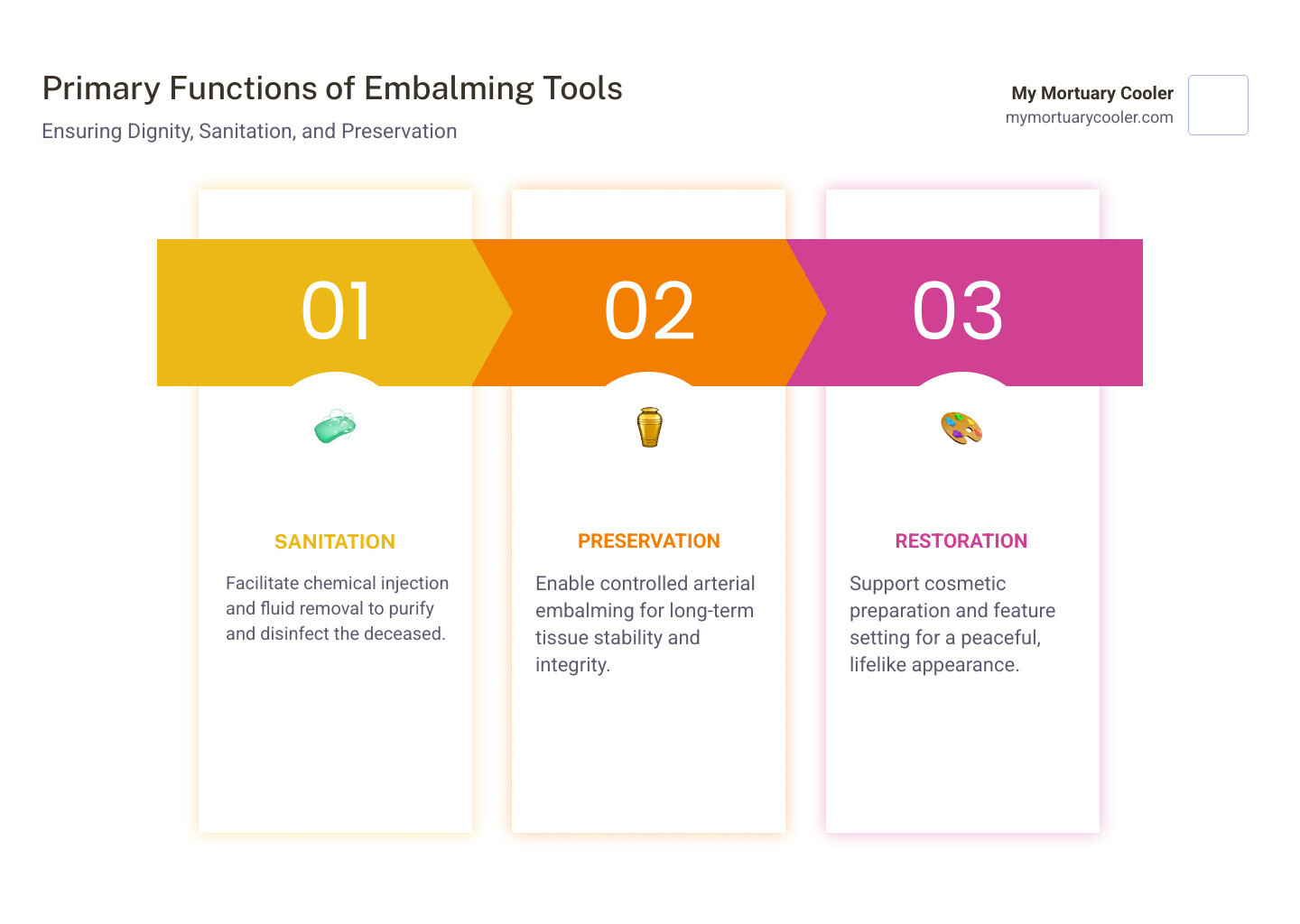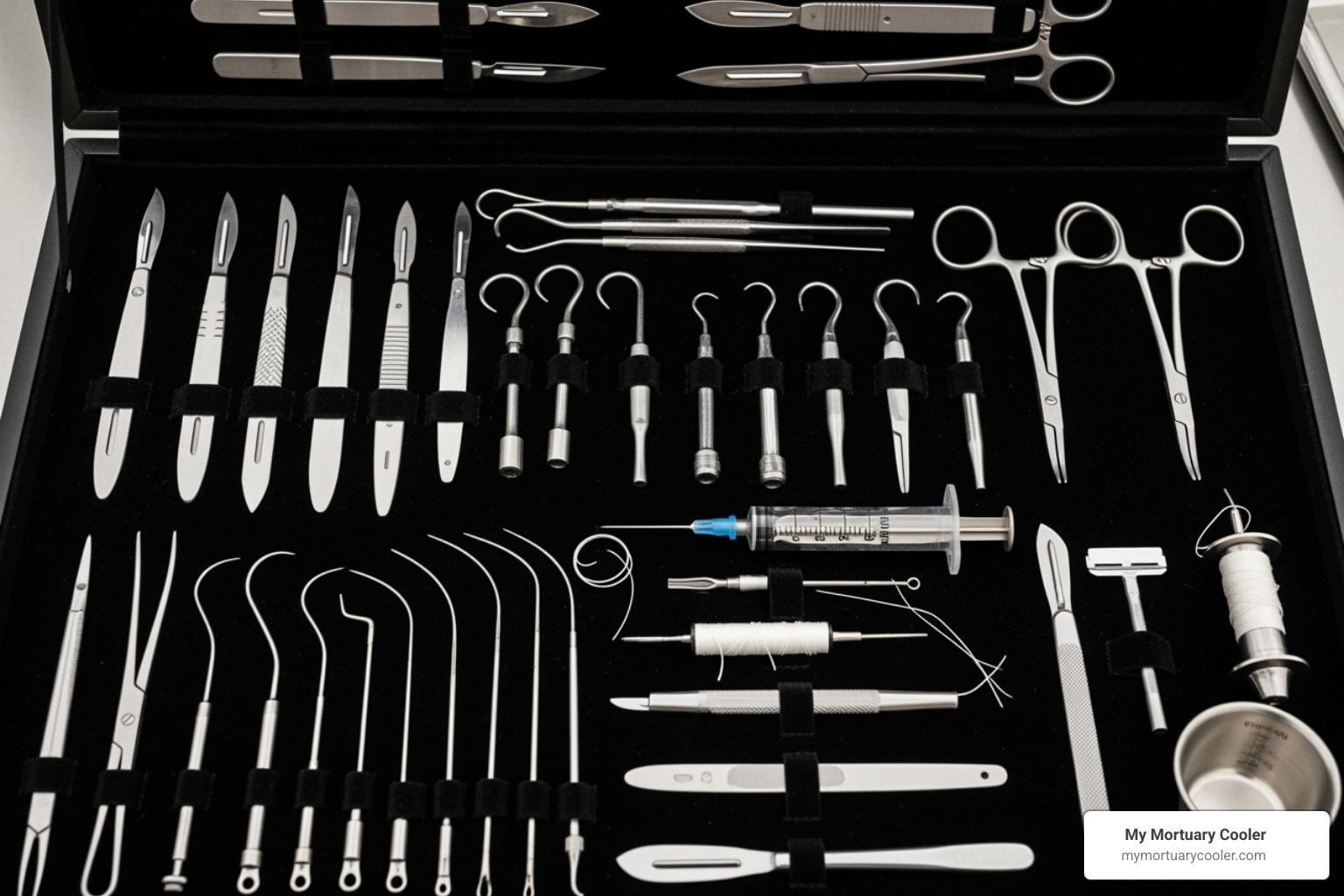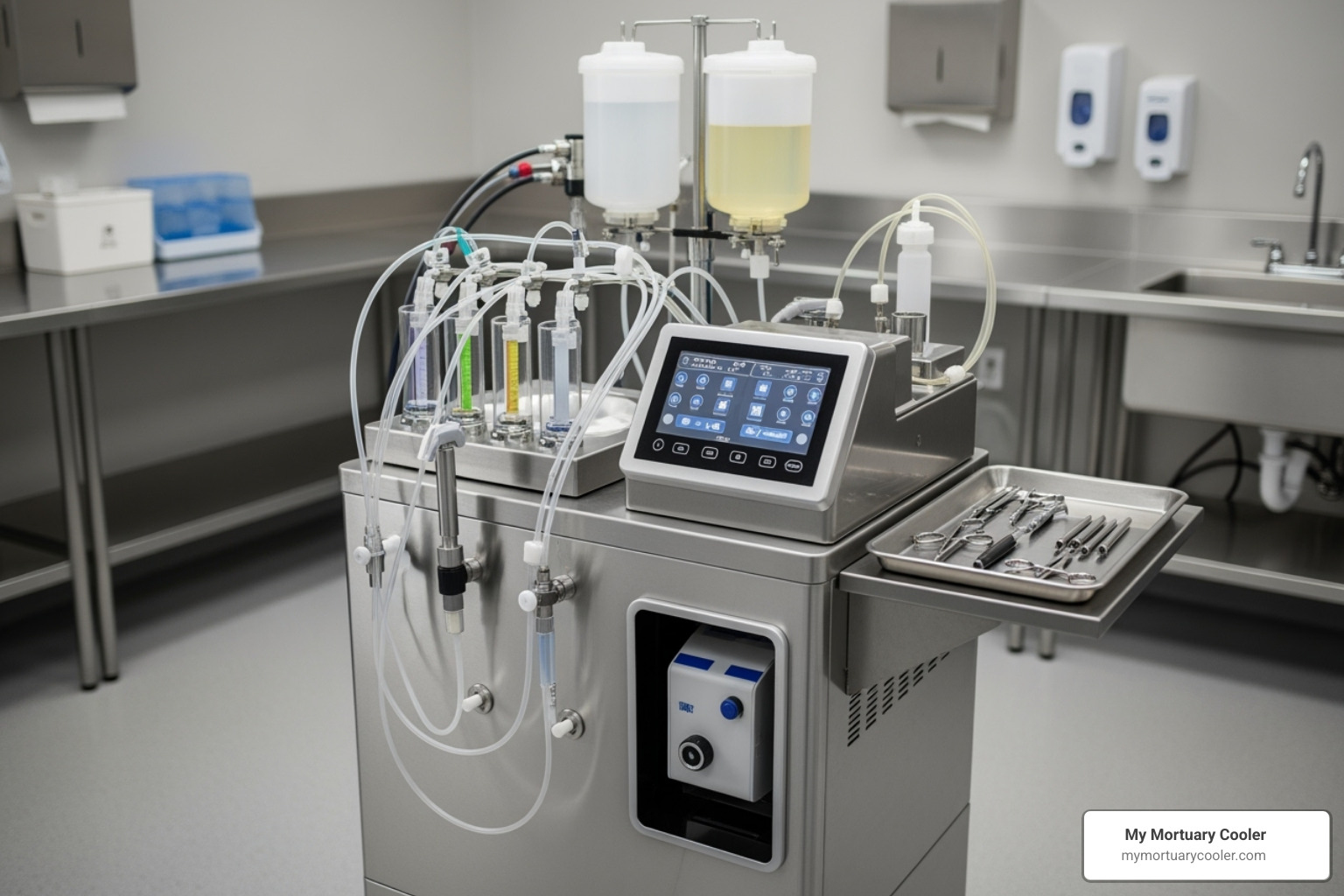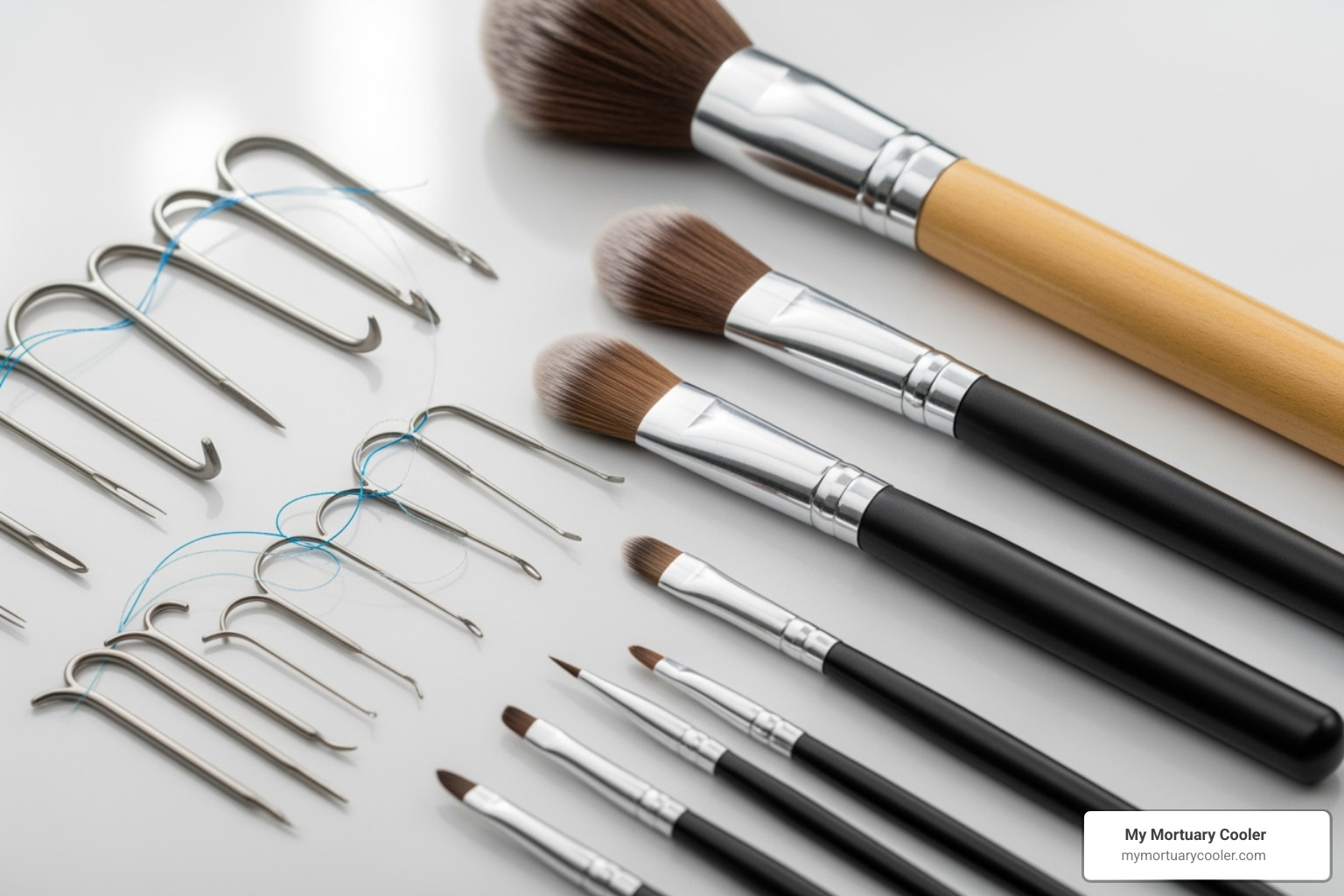Why Professional Embalming Tools Matter for Quality Care
Embalming tools are specialized instruments used by funeral professionals to preserve, sanitize, and restore the deceased. These precision instruments enable embalmers to inject preserving chemicals, remove bodily fluids, and perform restorative work that maintains dignity and provides comfort to grieving families.
Essential embalming tools include:
- Scalpels and blades for incisions
- Arterial tubes for injecting fluid
- Trocars for aspirating cavities
- Forceps for handling tissues
- Suture needles for closing incisions
- Embalming machines for controlling fluid flow
The global embalming services market was valued at USD 2.5 billion in 2022 and continues to grow. Modern embalming has evolved from simple hand pumps to sophisticated machines, highlighting the need for reliable, OSHA-compliant equipment. Understanding how to acquire the right tools ensures your facility can provide respectful, professional care.

#1: Start with a Comprehensive Instrument Kit

Starting with a comprehensive embalming tools instrument kit is a smart move when setting up or upgrading a prep room. These kits are designed for efficiency, keeping everything organized and accessible, which saves time and helps maintain professional standards. High-grade stainless steel tools offer the durability and precision needed for daily work and are easier to sterilize, ensuring years of reliable service.
Essential embalming tools for a complete kit
A complete kit should include core instruments for fundamental tasks:
- Scalpels and blades: The backbone of your cutting tools, typically #3 handles with disposable blades for clean incisions. Safety scalpels are a smart upgrade for accident prevention.
- Forceps: These come in several varieties. Arterial and fixation forceps securely grip arterial tubes, while dressing forceps handle delicate tissues. Clamping forceps like mosquito forceps help control small bleeds.
- Aneurysm hooks: These curved tools are useful for locating and isolating blood vessels, carefully raising arteries and veins for injection or drainage.
- Scissors: You'll need different types for various tasks. Operating scissors handle precise tissue work, while bandage scissors safely cut clothing.
- Suture needles: Essential for closing incisions, kits should include both S-shaped (double curved) and half-curved needles. The S-shaped needles are particularly useful for larger autopsy incisions.
- Directors and separators: These help guide vessels and create clear working spaces without damaging surrounding tissues.
A well-organized kit sets the tone for professional work. To learn more about these tools, check out our Embalming Tools 101: A Guide for the Curious and Slightly Creeped Out.
#2: Acquire Specialized Arterial and Drainage Instruments
After assembling your basic kit, the next step is acquiring specialized embalming tools for arterial injection and drainage. These instruments are the heart of vascular embalming, where fluid is injected into the arterial system while blood is removed from the venous system. This exchange sanitizes tissues, stops decomposition, and helps restore a lifelike appearance. Proper tools ensure this delicate balance is achieved with control and minimal disruption.
Key instruments in this category include:
Arterial Tubes: These conduits deliver embalming fluid into arteries. They come in various sizes and styles, including threaded for secure connections and slip-hub for quick attachment. The right tube ensures fluid spreads evenly.
Drain Tubes: Used in veins to remove blood and fluids, "Super Drain Tubes" are designed for highly efficient removal, helping to prevent blockages and bloating. Good drainage is key to a natural appearance.
Stopcocks and Y-Connectors: These small but vital devices control fluid flow. Stopcocks act as valves to direct or stop flow, while Y-Connectors allow for injection into multiple vessels at once, boosting efficiency.
Vein Forceps: Specialized "Angular Vein Forceps" have a unique angle that makes it easier to reach and manipulate veins, making drainage more effective.
Expert use of these instruments is critical for achieving the best possible preservation and restoration. For a broader understanding of the process, explore our [The Ultimate Guide to Embalming of Body: Understanding the Process](https://mymortuarycooler.com/blogs/news/the-ultimate-guide-to-embalming-of-body-understanding-the-process).
#3: Invest in a High-Quality Embalming Machine

An embalming machine is the heart of a modern prep room, changing the process from manual labor into a precise, manageable operation. A quality machine provides complete control over how embalming fluid enters the body. Pressure control allows you to adjust the force for each case, while consistent fluid delivery ensures preserving chemicals reach every tissue evenly.
This machine-assisted approach is far superior to manual methods, maintaining steady pressure and freeing you to focus on other critical tasks. The result is dramatically improved preservation quality, with fewer discolorations and more predictable results. Most quality machines feature durable stainless steel construction, making them easy to sanitize and built to last in a busy prep room.
Choosing the right machine is a significant investment. Our Beginners Guide to Buying an Embalming Machine can walk you through the process. A reliable machine is essential for providing the dignified, professional care that families deserve.
#4: Equip for Effective Cavity Treatment and Aspiration
After arterial injection, cavity treatment is a critical step for long-term preservation. This process addresses the internal organs in the thoracic, abdominal, and pelvic cavities, which arterial fluid may not fully reach. It involves aspirating (removing) fluids and gases, then injecting concentrated cavity fluid directly into the organs. Having the right embalming tools is essential for this "deep cleaning" phase.
- Trocars are the workhorses of cavity treatment. These long, hollow instruments with sharp tips puncture the cavity walls, allowing for both aspiration of fluids and injection of chemicals. Durable stainless steel trocars are a popular, reliable choice.
- Hydro-aspirators create the necessary suction. These devices use water pressure from a faucet to generate a powerful vacuum, drawing fluids through the trocar. Modern anti-clogging heads prevent interruptions.
- Cavity fluid injectors work with trocars to distribute chemicals. These can be simple attachments or more advanced models offering greater control over fluid delivery.
- Aspirator tubing and trocar buttons are key supporting tools. Quality tubing connects the hydro-aspirator to the trocar, while trocar buttons and applicators are used to seal the small puncture site for a neat, professional finish.
Mastering cavity treatment ensures comprehensive preservation from the inside out. For more information on embalming chemicals and their uses, see our A to Z guide to embalming chemicals and their uses.
#5: Select Instruments for Restoration and Closure

Once preservation is complete, the artistry of restoration begins. This is where embalming tools are used with compassion to create a peaceful, dignified appearance that brings comfort to grieving families. This phase requires a delicate touch and specialized instruments.
- Suture needles are central to closure. S-shaped (double curved) needles are valuable for large incisions, like those from autopsies, providing excellent leverage. Half-curved needles are versatile for smaller closures.
- Incision spreaders gently hold incisions open, giving clear access for suturing without obstruction.
- Spatulas, with their steel blades, are like an artist's palette knife, used to apply restorative waxes and blend cosmetics for natural-looking results.
- Eye caps are placed over the eyeball to maintain the natural contour of the eye and help keep the eyelids gently closed, contributing to a peaceful expression.
- Electric needle injectors and feature builders help set facial features. The injector uses small wires to maintain a naturally closed mouth, a technique essential for a serene appearance.
The final touches involve cosmetic work with combs, brushes, and makeup. As one funeral director noted, "When the embalming process is done, the cosmetizing starts... Looks like a beauty parlour after our cosmetician is done!" This attention to detail is the heart of funeral service. For more on the profession's commitment to care, see how embalming tools are vital for respect and care.
#6: Upgrade with Modern Technology and Embalming Tools
Mortuary science has evolved significantly, embracing technology to provide better, more respectful care. The change of embalming tools from simple hand pumps to precision machines reflects the industry's commitment to improvement.
Digital autopsy is a major advance, using CT or MRI scans to create detailed 3D models of the body. This allows for examination without invasive procedures, a respectful alternative that can provide critical data.
Non-invasive diagnostics like ultrasound and X-ray imaging help embalmers identify issues like fractures before beginning, allowing for better planning and reducing the need for extensive restoration.
Angiography, which images blood vessels using a contrast dye, helps detect blockages or other vascular issues. This knowledge leads to better fluid distribution and more predictable preservation outcomes.
These technological advances improve dignity by allowing professionals to work with greater precision while minimizing physical intervention. The evolution extends to other equipment, like specialized body positioners, ensuring respectful care for all. Embracing modern technology positions a funeral home at the forefront of mortuary care. Learn more in The Complete Guide to Buying Embalming Equipment.
#7: Partner with a Full-Service Mortuary Equipment Supplier
Choosing the right embalming tools and equipment is a critical decision that shapes your quality of care and prep room safety. Partnering with a full-service mortuary equipment supplier like My Mortuary Cooler is a strategic move to get everything you need.
When selecting equipment, consider these key factors:
- Quality and Durability: Invest in high-quality, surgical-grade stainless steel embalming tools. They resist rust, are easy to clean, and perform consistently, offering a longer life and lower replacement costs.
- Cost-Effectiveness: True value comes from long-term performance. Durable, reliable equipment saves money over time by minimizing repairs and downtime.
- OSHA Compliance and Safety: Your prep room must meet all OSHA standards. A trustworthy supplier provides equipment designed for safety, from embalming tables to safety scalpels, along with proper maintenance instructions.
- One-Stop-Shop Convenience: Sourcing all your embalming tools—from kits and machines to bariatric equipment—from one supplier simplifies purchasing, shipping, and support.
- Expert Guidance and Support: A full-service supplier offers more than products; we provide expertise to guide you to the right tools for your budget and operational needs.
By partnering with My Mortuary Cooler, you can be confident your prep room is equipped with the best embalming tools available. To see our wide range of offerings, visit our page on [Mortuary Equipment, Funeral Supply Solutions: Stretchers, Coolers, Racks, and Grossing Stations](https://mymortuarycooler.com/blogs/news/mortuary-equipment-funeral-supply-solutions-stretchers-coolers-racks-and-grossing-stations).
Frequently Asked Questions about Embalming Tools
Here are answers to some of the most common questions we hear about embalming tools.
What are the primary functions of embalming tools?
Embalming tools serve three core functions: sanitation, preservation, and restoration. They are used to sanitize the body by injecting preserving chemicals and removing fluids. They enable preservation by slowing decomposition and maintaining tissue integrity. Finally, they are used for restoration, helping to create a peaceful and lifelike appearance through cosmetic work and feature setting, which provides comfort to grieving families.
What are the most essential instruments in an embalming kit?
An essential embalming kit includes a core set of embalming tools for every stage of the process. This includes scalpels for incisions, arterial tubes for injecting fluid, various forceps for handling tissues, an aneurysm hook for isolating vessels, scissors for cutting, a trocar for cavity work, and suture needles for closing incisions. Together, these form the fundamental toolkit for any professional embalmer.
How do embalming machines improve the preservation process?
Modern embalming machines have revolutionized preservation by offering precise control over the pressure and flow rate of embalming fluid. Unlike inconsistent manual methods, a machine ensures a steady, adjustable flow. This leads to a more even distribution of chemicals throughout the vascular system, resulting in more thorough and uniform preservation. This control also minimizes the risk of tissue damage and allows the embalmer to focus on other critical tasks, leading to superior results.
Conclusion
Assembling the right collection of embalming tools is essential for providing dignified and respectful care. Each piece of equipment, from foundational kits to advanced machines, plays a vital role in the preservation and restorative art process. Modern technology has further improved precision, allowing professionals to honor the deceased with the utmost respect.
When you source high-quality, compliant embalming tools from a trusted authority like My Mortuary Cooler, you are equipping your prep room for excellence. We understand the importance of reliable equipment in upholding the highest standards of the profession.
Ready to explore a comprehensive range of professional-grade equipment? We invite you to read our Practical Guide to Embalming Instruments and Their Uses.